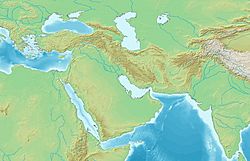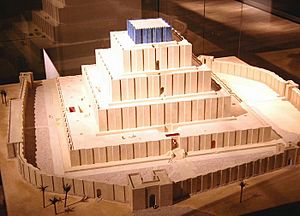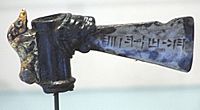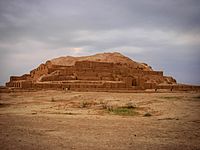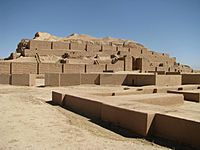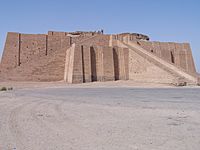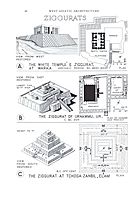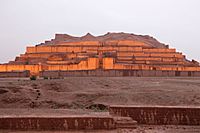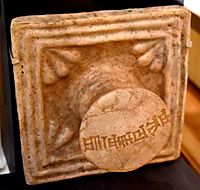Chogha Zanbil facts for kids
|
چغازنبيل (Persian)
Dur Untash (Elamite) |
|
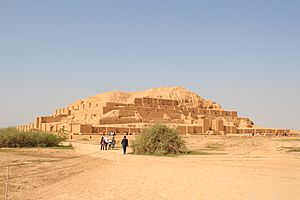
Ziggurat at Chogha Zanbil
|
|
| Location | Khuzestan Province, Iran |
|---|---|
| Coordinates | 32°0′30″N 48°31′15″E / 32.00833°N 48.52083°E |
| Type | Settlement |
| History | |
| Builder | Untash-Napirisha |
| Founded | 1250 BC |
| Abandoned | 640 BC |
| Cultures | Elamite |
| Site notes | |
| Excavation dates | 1951–1961 |
| Archaeologists | Roman Ghirshman |
| Condition | In ruins |
| UNESCO World Heritage Site | |
| Official name | Tchogha Zanbil |
| Criteria | Cultural: (iii), (iv) |
| Inscription | 1979 (3rd Session) |
Chogha Zanbil (Persian: چغازنبيل; Elamite: Dur Untash) is an ancient Elamite complex in the Khuzestan province of Iran. It is one of the few existing ziggurats outside Mesopotamia. It lies approximately 30 km (19 mi) southeast of Susa and 80 km (50 mi) north of Ahvaz.
History and etymology
The Elamite language is a language isolate Chogha Zanbil is typically translated as 'basket mound.' It was built about 1250 BC by the king Untash-Napirisha, mainly to honor the great god Inshushinak. Its original name was Dur Untash, which means 'town of Untash' in Assyrian, but it is unlikely that many people, besides priests and servants, ever lived there. The complex is protected by three concentric walls which define the main areas of the 'town'. The inner area is wholly taken up with a great ziggurat dedicated to the main god, which was built over an earlier square temple with storage rooms also built by Untash-Napirisha.
The middle area holds eleven temples for lesser gods. It is believed that twenty-two temples were originally planned, but the king died before they could be finished, and his successors discontinued the building work. In the outer area are royal palaces, a funerary palace containing five subterranean royal tombs.
Although construction in the city abruptly ended after Untash-Napirisha's death, the site was not abandoned, but continued to be occupied until it was destroyed by the Assyrian king Ashurbanipal in 640 BC. Some scholars speculate, based on the large number of temples and sanctuaries at Chogha Zanbil, that Untash-Napirisha attempted to create a new religious center (possibly intended to replace Susa) which would unite the gods of both highland and lowland Elam at one site.
The ziggurat originally measured 105.2 metres (345 ft) on each side and about 53 metres (174 ft) in height, in five levels, and was crowned with a temple. Mud brick was the basic material of the whole ensemble. The ziggurat was given a facing of baked bricks, a number of which have cuneiform characters giving the names of deities in the Elamite and Akkadian languages. Though the ziggurat now stands only 24.75 metres (81.2 ft) high, less than half its estimated original height, its state of preservation is unsurpassed. [1]
The ziggurat is considered to be the best preserved example of the stepped pyramidal monument by UNESCO. In 1979, Chogha Zanbil became the first Iranian site to be inscribed on the UNESCO World Heritage List.
Archaeology
Chogha Zanbil was excavated in six seasons between 1951 and 1961 by Roman Ghirshman.
Threats
Petroleum exploration due to increased global demand threatens the foundations of the site, as various seismic tests have been undertaken to explore for reserves of petroleum. Digging for oil has been undertaken as close as 300 metres (984 ft) away from the ziggurat.
Gallery
See also
 In Spanish: Choga Zanbil para niños
In Spanish: Choga Zanbil para niños
- Step pyramid
- Iranian architecture
- List of Iranian castles, citadels, and fortifications
- Cities of the ancient Near East



